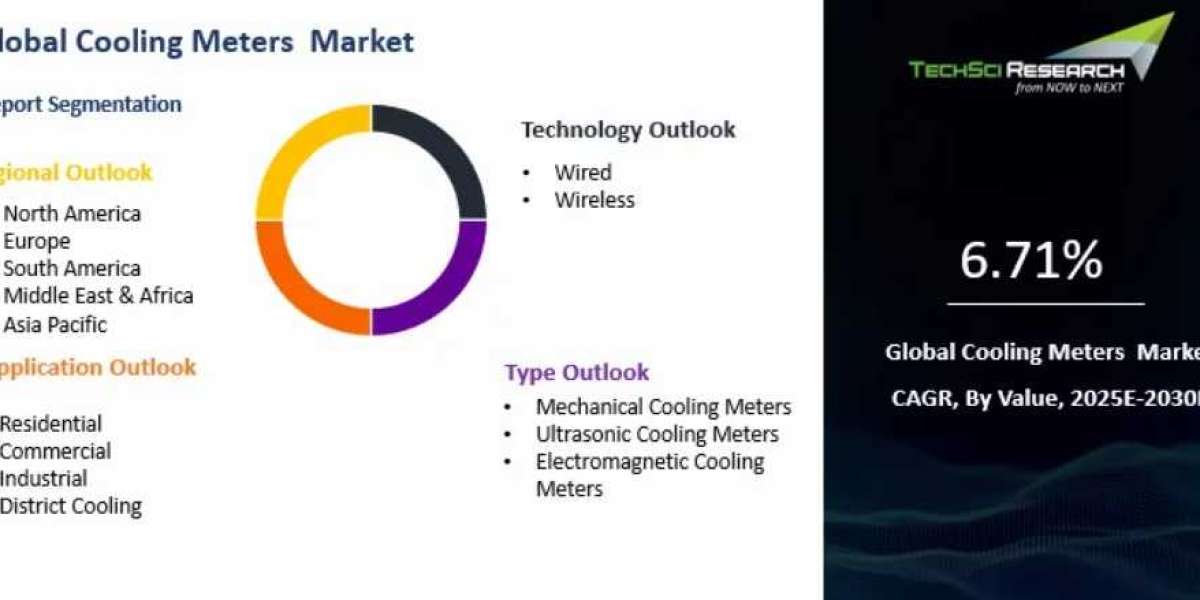According to the TechSci Research report, “Cooling Meters Market – Global Industry Size, Share, Trends, Competition Forecast Opportunities, 2020–2030F”, the Global Cooling Meters Market was valued at USD 1.34 billion in 2024 and is projected to reach USD 2.00 billion by 2030, growing at a CAGR of 6.71% during the forecast period. The market is entering a transformative phase, primarily driven by the shift from conventional mechanical meters toward ultrasonic and electromagnetic technologies. This transition is redefining product lifecycles, energy measurement accuracy, and integration with digital building ecosystems.
Transition from Mechanical to Advanced Cooling Meters
For decades, mechanical cooling meters dominated the market due to their affordability and ease of installation. However, their limitations—such as susceptibility to wear and tear, short lifespans, and reduced accuracy under variable conditions—are pushing users toward digital alternatives. In contrast, ultrasonic meters have emerged as a preferred technology, offering non-intrusive, maintenance-free operation and greater precision in flow and energy measurements. By using sound waves to calculate fluid velocity, ultrasonic meters can also detect flow direction, low-flow conditions, or air bubbles—scenarios that often challenge mechanical devices.
Electromagnetic meters, while less widely adopted in cooling applications due to their dependency on conductive fluids, are steadily gaining traction in specialized projects. Their strength lies in precise, real-time monitoring in niche conditions, contributing to the gradual diversification of technologies within the global market.
Advantages of Ultrasonic Cooling Meters
The rise of ultrasonic meters is fueled by their non-mechanical design, which extends product lifecycles to 10–15 years compared to the shorter lifespan of traditional options. They also perform reliably in harsh environments and district cooling networks, which demand accuracy and durability. Beyond measurement, ultrasonic meters are designed to support real-time data transmission, remote diagnostics, and seamless integration with smart building platforms and Building Energy Management Systems (BEMS).
Industry data reveals that in Europe, more than 65% of new cooling meter installations in 2023 were ultrasonic models—a trend that continues to accelerate. Similarly, in the Asia-Pacific region, markets such as China and Singapore are adopting ultrasonic solutions within green building programs. Rapid advancements in sensor technology, microelectronics, and economies of scale are also reducing the cost of ultrasonic components, improving affordability and adoption. While initial investments remain higher than mechanical options, long-term benefits in terms of accuracy, tamper resistance, energy savings, and digital connectivity justify their preference.
Market Opportunity in Wireless Cooling Meters
When segmented by technology, wireless cooling meters are emerging as the fastest-growing category globally. The rising demand for flexible, scalable, and cost-effective solutions in smart infrastructure is fueling adoption. Unlike wired systems, wireless meters minimize installation complexity and costs, making them suitable for both retrofits and new-build projects.
These systems leverage communication protocols like LoRaWAN, NB-IoT, Zigbee, and wM-Bus, enabling long-range, low-power, and reliable data transfer. This is particularly beneficial in multi-tenant complexes, district cooling systems, and geographically dispersed facilities, where wired connections may be impractical or costly.
The adoption of wireless meters is closely tied to smart building and smart city initiatives. Their ability to deliver real-time monitoring, automated billing, and consumption analytics supports greater energy optimization and operational efficiency. Utilities and energy service providers are increasingly attracted to wireless options because they offer remote diagnostics, predictive maintenance, and firmware upgrades, reducing service costs and downtime.
Government regulations are also playing a crucial role. For example, European Union policies now mandate thermal sub-metering in multi-unit residential and commercial buildings, with a preference for remotely readable devices. Similarly, digitization programs across North America and Asia-Pacific are accelerating smart meter rollouts. As battery innovations and device miniaturization improve meter longevity and reliability, wireless cooling meters are set to dominate future installations.
Browse over XX market data Figures spread through XX Pages and an in-depth TOC on the " Global Cooling Meters Market"
https://www.techsciresearch.com/report/cooling-meters-market/29928.html
Regional Insights: Asia-Pacific Leading Growth
Regionally, Asia-Pacific (APAC) is expected to record the fastest growth in the global cooling meters market during 2026–2030. This expansion is driven by rapid urbanization, rising energy efficiency demands, and adoption of smart infrastructure solutions. Countries such as China, India, Japan, South Korea, and Singapore are experiencing strong growth in residential, commercial, and industrial construction, fueling demand for reliable cooling metering technologies.
A key growth driver in APAC is the expansion of district cooling networks, particularly in rapidly urbanizing countries. For instance, China and India are heavily investing in centralized cooling solutions for smart cities and commercial real estate projects. District cooling requires precise sub-metering and consumption-based billing, thereby generating strong demand for advanced cooling meters.
Government initiatives are reinforcing this momentum. Programs like India’s Energy Conservation Building Code (ECBC) and Singapore’s Green Mark Scheme promote sustainable building design and energy monitoring compliance, creating regulatory push for cooling meter installations. Smart city development initiatives, supported by public-private partnerships, are further driving demand.
Additionally, APAC markets benefit from cost reductions in ultrasonic and wireless cooling technologies, making them more accessible to developing economies. A large base of regional manufacturers and system integrators ensures product availability while reducing dependency on imports and allowing for localized customization.
Climate factors also play a role: rising urban heat island effects, higher average temperatures, and expanding middle-class populations are leading to increased per capita cooling demand, especially in India, Vietnam, Thailand, and Indonesia. These trends reinforce the necessity of precise, reliable metering for accountability and efficiency.
Conclusion
The global cooling meters market is transitioning toward a digitally integrated, smart-enabled future, with ultrasonic and wireless technologies spearheading adoption. As urbanization, climate challenges, and energy efficiency targets converge, the need for accurate, reliable, and intelligent cooling measurement systems will intensify.
While Europe continues to set benchmarks in adoption, Asia-Pacific is emerging as the most dynamic growth hub, backed by government initiatives, smart city programs, and growing infrastructure investments. Looking ahead, as IoT, data analytics, and BEMS platforms become central to energy management, cooling meters will serve as an indispensable component in achieving sustainable and cost-efficient cooling solutions worldwide.
Key market players in the Global Cooling Meters market are:
Siemens AG
Kamstrup A/S
Diehl Metering GmbH
Danfoss A/S
Itron Inc.
Zenner International GmbH Co. KG
Landis+Gyr AG
B METERS s.r.l.
Engie
Apator SA
Download Free Sample Report
https://www.techsciresearch.com/sample-report.aspx?cid=29928
Customers can also request for 10% free customization on this report.
“The global cooling meters market presents significant opportunities driven by the expansion of district cooling systems, rising demand for energy-efficient buildings, and increased adoption of smart technologies. Growth in urbanization across emerging markets, particularly in Asia Pacific and the Middle East, is boosting demand for sub-metering and consumption-based billing. Government regulations promoting green buildings and sustainability further support market penetration.
Additionally, innovations in wireless communication, IoT integration, and cloud-based data analytics are creating new revenue streams for vendors. As cooling demand surges in commercial, residential, and industrial sectors, the market offers strong potential for technologically advanced, cost-effective metering solutions.” said Mr. Karan Chechi, Research Director of TechSci Research, a research-based Global management consulting firm.
“Cooling Meters Market - Global Industry Size, Share, Trends, Opportunity, and Forecast, Segmented By Technology (Wired, Wireless), By Type (Mechanical Cooling Meters, Ultrasonic Cooling Meters, Electromagnetic Cooling Meters), By Application (Residential, Commercial, Industrial, District Cooling), By Region Competition, 2020-2030F,” has evaluated the future growth potential of Global Cooling Meters Market and provides statistics information on market size, structure, and future market growth. The report intends to provide cutting-edge market intelligence and help decision makers take sound investment decisions. Besides the report also identifies and analyzes the emerging trends along with essential drivers, challenges, and opportunities in Global Cooling Meters Market.
Contact
TechSci Research LLC
420 Lexington Avenue,
Suite 300, New York,
United States- 10170
M: +13322586602
Email: sales@techsciresearch.com
Website: https://www.techsciresearch.com







